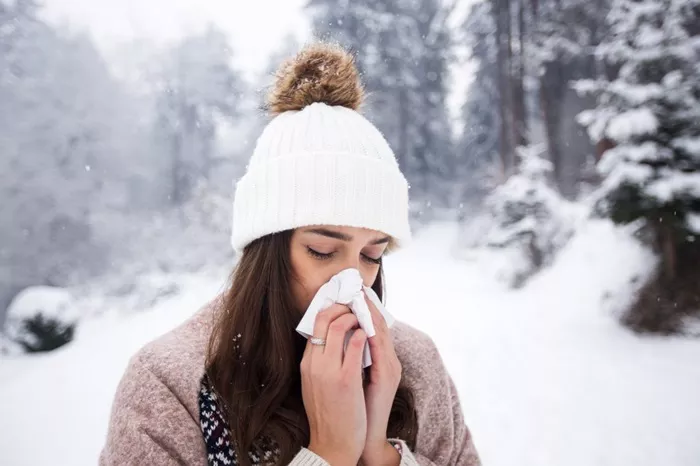Seasonal allergies are commonly associated with spring and fall, when pollen counts are high and environmental allergens abound. However, many individuals overlook the fact that allergies can also strike during the winter months. While winter typically brings relief for those with pollen allergies, it introduces a host of other allergens that can trigger symptoms ranging from mild discomfort to severe respiratory issues. Understanding the causes, symptoms, and management of winter allergies is essential for individuals seeking relief during the colder months.
1. Causes of Winter Allergies
Contrary to popular belief, winter allergies are not solely caused by cold weather. Instead, they arise from indoor triggers and environmental factors specific to the winter season. Some common causes include:
a. Indoor Allergens: Spending more time indoors during the winter exposes individuals to a variety of indoor allergens such as dust mites, pet dander, mold, and indoor pollutants like smoke and fumes from fireplaces. Poor indoor air quality exacerbates allergic reactions and respiratory symptoms.
b. Mold Spores: Cold and damp conditions create ideal environments for mold growth, which thrives in poorly ventilated areas such as bathrooms, kitchens, and basements. Mold spores released into the air can trigger allergic reactions in susceptible individuals.
c. Dust Mites: Increased time spent indoors during winter allows dust mites, microscopic organisms found in bedding, upholstery, and carpets, to proliferate. Exposure to dust mite allergens can lead to sneezing, coughing, and nasal congestion.
d. Indoor Heating Systems: Heating systems, particularly forced-air systems and wood-burning stoves, can circulate allergens throughout indoor spaces. Additionally, dry air from central heating can irritate nasal passages and exacerbate respiratory symptoms.
2. Symptoms of Winter Allergies
The symptoms of winter allergies often mimic those of the common cold or flu, making diagnosis challenging. Recognizing the distinguishing features of winter allergies can help individuals differentiate between allergies and other respiratory illnesses. Common symptoms include:
a. Nasal Congestion: Allergic rhinitis, or inflammation of the nasal passages, can cause nasal congestion, itching, and sneezing. Individuals may experience a runny or stuffy nose, often accompanied by clear nasal discharge.
b. Itchy Eyes: Allergic conjunctivitis manifests as itchy, watery eyes and redness, resembling symptoms of eye irritation due to exposure to allergens such as dust mites or pet dander.
c. Coughing and Wheezing: Winter allergies can trigger coughing and wheezing, particularly in individuals with underlying respiratory conditions such as asthma. Persistent coughing, chest tightness, and difficulty breathing may indicate allergic asthma.
d. Skin Irritation: Some individuals may develop allergic skin reactions, such as eczema or hives, in response to exposure to indoor allergens or irritants present during winter months.
e. Fatigue: Chronic allergic symptoms can lead to fatigue and decreased energy levels, impacting overall quality of life and productivity.
3. Diagnosis and Management
Proper diagnosis and management of winter allergies involve identifying triggers, implementing preventive measures, and seeking appropriate medical treatment when necessary. Key strategies include:
a. Allergy Testing: Consultation with an allergist can help identify specific allergens triggering winter symptoms through skin prick tests or blood tests. Understanding individual triggers is essential for targeted management.
b. Environmental Control: Minimizing exposure to indoor allergens is crucial for managing winter allergies. Strategies include regular cleaning to reduce dust and mold, using allergen-proof bedding covers, and maintaining optimal indoor humidity levels.
c. Air Filtration: High-efficiency particulate air (HEPA) filters can help remove airborne allergens, including dust mites and mold spores, from indoor environments. Consider using HEPA filters in vacuum cleaners, air purifiers, and HVAC systems to improve indoor air quality.
d. Medication: Over-the-counter and prescription medications can provide symptomatic relief for winter allergies. Antihistamines, decongestants, nasal corticosteroids, and allergy eye drops are commonly used to alleviate nasal congestion, sneezing, itching, and eye irritation.
e. Immunotherapy: Allergen immunotherapy, such as allergy shots or sublingual immunotherapy tablets, may be recommended for individuals with severe or persistent allergies. Immunotherapy aims to desensitize the immune system to specific allergens, reducing allergic reactions over time.
f. Asthma Management: Individuals with allergic asthma should adhere to their prescribed asthma treatment plan, including controller medications and rescue inhalers. Close monitoring of asthma symptoms and regular follow-up with a healthcare provider are essential for optimal asthma management during winter.
4. Prevention Strategies
Preventing winter allergies involves proactive measures to minimize exposure to indoor allergens and maintain a healthy indoor environment. Consider the following preventive strategies:
a. Indoor Cleaning: Regular cleaning, vacuuming, and dusting can help reduce indoor allergens such as dust mites, pet dander, and mold. Use a vacuum cleaner equipped with a HEPA filter to trap allergens effectively.
b. Humidity Control: Maintain indoor humidity levels between 30% and 50% to inhibit mold growth and minimize dust mite proliferation. Use a humidifier or dehumidifier as needed to achieve optimal humidity levels.
c. Pet Care: Bathe pets regularly and keep them off furniture and bedding to minimize exposure to pet dander, a common allergen. Consider using allergy-friendly bedding materials and designated pet-free zones within the home.
d. Ventilation: Improve indoor air circulation by opening windows periodically, using exhaust fans in bathrooms and kitchens, and ensuring proper ventilation in basements and attics to prevent mold growth.
e. Outdoor Precautions: When engaging in outdoor activities during winter, wear appropriate clothing to avoid bringing outdoor allergens such as pollen or mold spores indoors. Shower and change clothes after outdoor activities to remove allergens from skin and clothing.
5. Conclusion
While winter allergies may not receive as much attention as their springtime counterparts, they can significantly impact individuals’ quality of life during the colder months. By understanding the causes, symptoms, and management strategies for winter allergies, individuals can take proactive steps to minimize exposure to indoor allergens and seek appropriate medical treatment when necessary. With proper prevention and management, individuals can enjoy a symptom-free winter season despite the presence of allergens in their environment.
[inline_related_posts title=”You Might Be Interested In” title_align=”left” style=”list” number=”6″ align=”none” ids=”6023,6034,6067″ by=”categories” orderby=”rand” order=”DESC” hide_thumb=”no” thumb_right=”no” views=”no” date=”yes” grid_columns=”2″ post_type=”” tax=””]
































